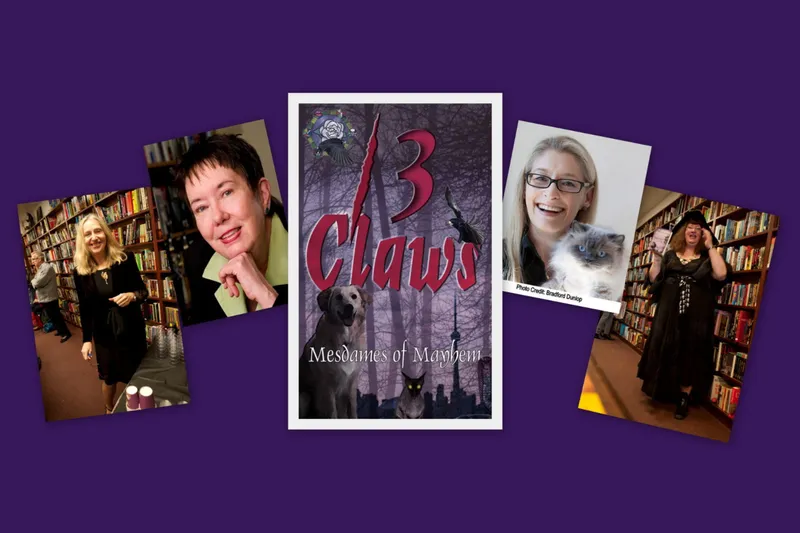The stories in 13 Claws, by the Mesdames of Mayhem, range from cosy mysteries to thrillers and are based upon the writers’ love of animals.
First and foremost, congratulations on the four Arthur Ellis nominations for 13 Claws!
M. H. Callway: THANKS, Vanessa! We are delighted to be guesting on your new blog. With me today are Mmes Mel Campbell, Lisa De Nikolits and Rosemary McCracken.
In “Homebodies”, Rosemary McCracken writes, “Everyone’s pet is special”. This is certainly the case in 13 Claws, in which all of the stories share an animal motif. This balance between the love of animals and the darkness of murder provides fertile ground for the humour pervading many of these stories. How did you decide on the animal theme?
M. H. Callway: Jane Burfield and I both had stories in the Christmas crime anthology, Blood on the Holly (Baskerville Press, 2008). The holiday theme really tied the collection together and since we are both love animals, we thought what fun it would be to do an animal-centred anthology some day. But life intervened, as they say, until it was time for the Mesdames‘ third anthology.
Lisa De Nikolits: And I believe the animal theme came about after our publisher, Donna Carrick’s beloved golden retriever, Daisy, passed on. We all leapt at it with great enthusiasm!
M. H. Callway: And indeed many stories in 13 Claws do have humourous elements, but surprisingly most show a darker edge. Sylvia Warsh’s Arthur Ellis-nominated story, “The Ranchero’s Daughter” explores madness and the eternal question: do animals have souls? And though Jane’s story, “There Be Dragons”, reads like a children’s fantasy adventure, it’s also a reflection on family heredity and fate. Needless to say, my own novella, Snake Oil, which centres on snakes and real estate agents is classic noir as is Cathy Astolfo’s story, “The Outlier ” about a fugitive and his pet pig…
Many of the animals featured in these stories possess anthropomorphic qualities. As crime writers, what were the benefits of plotting a crime revolving around an animal that has human-like characteristics?
Rosemary McCracken: I love cats but, sadly, I’m allergic to them. About 10 years ago, a marmalade tabby “adopted” my husband Ed and me. I named him Romeo because he spent the first few nights outside on our Juliet balcony because I was trying to minimize my contact with him. We soon took him inside at night because he was so vocal in his protests that he woke up the neighborhood. I desperately wanted to keep Romeo so Ed, who had never been in contact with cats before, took over the job of caring for him. My story, “Homebodies”, depicts the relationship between Henry, a man who is wary of cats, and a cat who is determined to be second to nobody in the house.
My cat, Romeo, had a mind of his own in all matters so he was was a natural inspiration for this story. Henry and Romeo develop a guarded respect for each other and Romeo comes to the rescue with his special cat skills. But his loyalty has its limits. He’ll fight an armed intruder, but he won’t demean himself by cuddling with Henry on the sofa!
Lisa De Nikolits: I have two stories in the anthology, but I’m not sure that either animal has human-like characteristics. I really love the idea of the silent witness. Animals are such innocent friends and I guess I do embue them with human-like qualities of seeing and interpreting events, and for having affiliations to one person versus another.
“Blood and Apricots” was a story I‘d wanted to write for a long time, after knowing a woman whose cat once belonged to a serial killer. In my story, a dog witnesses a husband murdering his wife. T experience related in “Blood and Apricots” is a childhood memory of mine, cloaked in mists and darkness – one of those vague did that really happen things?
I wrote “Mad Dog and the Sea Dragon” after I saw Mad Dog Esposito’s portrait at the WeeGee exhibit in Toronto. That crazy face, that wild expression! And why a leafy sea dragon? Well, I saw one at the Toronto Ripley’s Aquarium and I fell in love. In my story, a leafy sea dragon keeps a mafioso boss’s mistress company during her lonely hours as she waits for her demise – or her rescue. We know that the fish witnessed a crime, but as with the dog, we leave the story without knowing if justice was done.
Interestingly, my husband revisited Ripley‘s recently and sadly, my leafy sea dragon had passed on. This may or may not be true at all, but one feels that a sense of immortality is attributed to a person or dog or even a thing, if they are penned in a story or poem or book. Perhaps it‘s simply that a written expression of love helps us heal, or that the loved person or creature will never be forgotten.
Even better, after I wrote “Mad Dog and the Sea Dragon” for 13 Claws, it developed into a full length novel. The working title has morphed into The WeeGee Doll and Daisy, the leafy sea dragon, still lives there!
The Mesdames of Mayhem are all established Canadian crime writers. How important is a Canadian setting in your fiction?
Melodie Campbell: It’s very important. It defines us, just as Scandinavian settings define Swedish, Norwegian and Danish writers. I set my books in Hamilton, The Hammer, which is a character all in itself. Our skyline includes steel plants. We consider smog a condiment.
Rosemary McCracken: It depends on the story. I mention a few Canadian landmarks in “Homebodies,” but the story could be set anywhere in the western world. My three Pat Tierney mystery novels, however, are set in Canada. Pat is a financial planner, and the plots depend on elements particular to Canada’s financial services industry.
M. H. Callway: Most of my stories grow out of a setting and those settings are almost always Canadian. My creativity gets fired up by our local geography and landmarks – the more curious the better. In Snake Oil, the house my real estate protagonist, Bella, tries to sell is a blend of all the Toronto Victorian brick homes I’ve ever been in – even the one that’s our home. And the setting for my novel, Windigo Fire, is Northern Ontario and couldn’t happen anywhere else.
Lisa De Nikolits: Like Rosemary, I believe that setting depends on the story and the characters. West of Wawa was about a bus trip across Canada so the Canadian setting was of vital importance there! But in “Blood and Apricots“ and “Mad Dog and the Sea Dragon“ the animals were more important that the setting, which could be in any city in any country.
My novels are set in South Africa (The Witchdoctor’s Bones) or in Toronto (Between the Cracks She Fell, The Nearly Girl). (No Fury Like That is set in Purgatory so I guess that one doesn’t count!) My new novel, Rotten Peaches (coming in Fall 2018), is set in Toronto and Johannesburg but it also travels across the U.S. visting various Home and Gift Trade Shows.
In your opinion, what are some of the prevailing challenges women crime writers face today?
Melodie: We do face a ghetto still. For instance, the current female-authored bestsellers (Gone Girl, Girl on a Train, The Wife, The Good Daughter) are being classified as Domestic Noir. Why domestic? Why not just noir? I hate the patronizing. Which is why I write about women in the mob. Just try to patronize them – grin.
M. H. Callway: I agree with Mel. Many readers expect a thriller and noir writer like myself to be male. Sometimes I feel I’m fighting an uphill battle especially after working in the male-dominated fields of science, IT and consulting! But women today write pretty tough stuff: witness best-selling authors Gillian Flynn and Hilary Davidson. This means that attitudes are changing…hopefully.
Lisa De Nikolits: I think it’s a great time to be a female crime writer, but there are challenges for sure. My particular challenges vary from those of other writers, because I don’t write pure genre crime. Sometimes booksellers and reviewers aren’t sure where to categorize my work and so I get sidelined.
I find that North America is incredibly attached to categorization and if you don’t fit neatly into a slot, then you can be ignored. Which is a terrible thing for a writer!
Another challenge is that there are so many books out there, it is very hard to get your book noticed. Being published by a small independent publisher is not Amazon’s favourite thing at all. For example, if I review a friend’s novel, Amazon can remove my review at their discretion simply because I am a writer. Perhaps they feel I am not objective. But I am also a reader. What happened to free speech?
As stated on your website, mesdamesofmayhem.com, many of you are accomplished teachers and mentors. Donna Carrick, the editor of 13 Claws also offers tips to writers on her podcast “Dead to Writes”. If you had to give just one piece of advice to aspiring crime writers, what would it be?
Melodie: Writing takes time - a lot of time. It must be the third most important thing in your life. After family. After your day job. But before anything else.
M. H. Callway: Be tough. A career in writing requires resilience. Even established writers get rejected from time to time. Never give up. Persistence is as important as talent – maybe even more so.
Rosemary: I teach novel writing at George Brown College, and most of my current crop of students are in their twenties and thirties. I tell them what an advantage their age gives them. Writing improves and deepens with practice, and if they dedicate a certain amount of time to it every week – even though that will probably mean juggling full-time jobs and raising families – they will have honed their craft by the time they hit their forties. Of course, writers have been known create a bestseller on their first try. But that doesn’t happen very often.
Lisa: I’ve had one rule, or one tip, for many many years and it has stood me in good stead! It’s this: Do One Thing A Day For Your Writing. Write a paragraph, or a sentence, or a chapter or five thousand words. Don’t worry about which of those things it will be, just do the one thing. And the one thing does not include posting on social media, or reading a book or even studying the art of writing, it has to be writing!
Thanks so much, Vanessa, for hosting us on your blog.
Readers can get a copy of 13 Claws, the latest anthology by the Mesdames of Mayhem, on Amazon.ca, at Sleuth of Baker Street bookstore and in the Toronto Public Library.

About Vanessa Westermann
Vanessa writes feel-good romantic mysteries. She is the author of Cover Art and other books.

